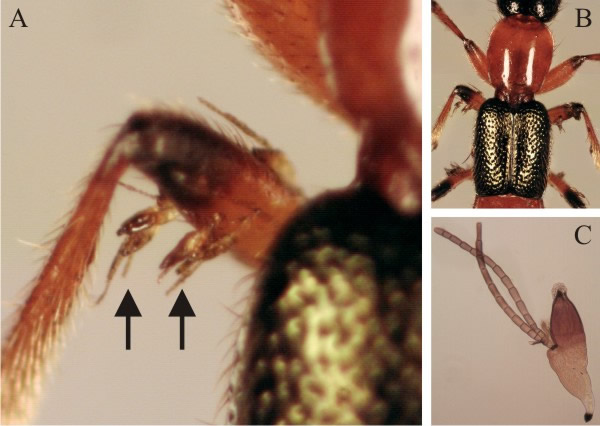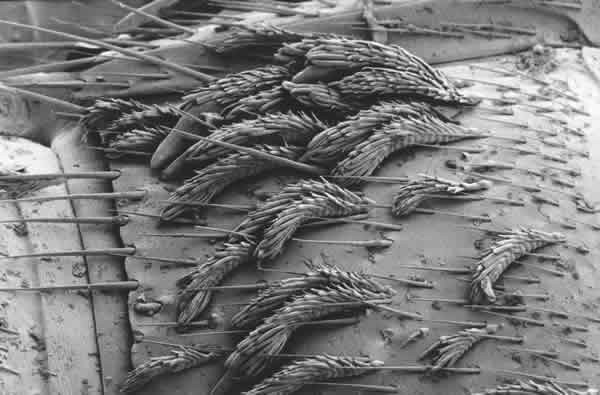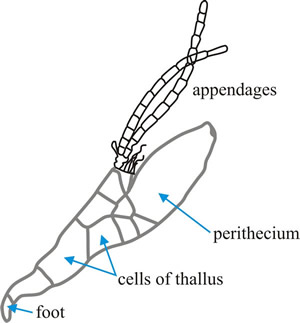16.4 Laboulbeniales
The Laboulbeniales is an order of fungi within the class Laboulbeniomycetes (Ascomycota) (see Chapter 3). The group consists of over 2000 species that are obligate biotrophs (ectoparasites) of insects (mostly beetles; Fig. 4), mites, and millipedes. They are possibly the most unusual microfungi known because they have no hyphae but cellular thalli (Fig. 4C), formed by enlargement and subsequent cell divisions of the two-celled ascospore, that parasitises the host through a foot cell which penetrates the insect cuticle with a haustorium and permits the fungus to extract nutrients from the insect body tissues, although the fungal parasites in this group do not cause much damage to the host (Blackwell, 1994; Weir & Beakes, 1995).
An interesting example of a tritrophic association is one in which bats are parasitised by dipteran bat flies, obligate blood-sucking parasites, which in turn may be parasitised by fungi of the Laboulbeniales (de Groot et al., 2020).
 |
Fig. 4. Laboulbenia cristata on the legs of a
Rove Beetle (Paederus riparius). A, shows the
Laboulbenia fruit bodies (arrowed) in situ on one of the
legs, and a lower magnification image (B) shows the
scale in relation to the rest of the insect. C, shows a
Laboulbenia cristata fruit body separated from the leg of a Rove
Beetle and mounted in lactophenol for photomicrography. Photographs by
Malcolm Storey (http://www.bioimages.org.uk).
Images kindly provided by Malcolm Storey. |
Although the thallus is morphologically diverse in the group as a whole, in each species it consists of a defined number of cells (that is, the thallus shows determinate growth) in a particular arrangement that may include plume-like appendages that help in ascospore release. These appendages, and the small size of the thallus, make the ectoparasitic fungus look like bristles on the host, so it can be easil;y overlooked (Figs 4 and 5). So far, the DNA isolations and PCR amplifications that are essential for genomics analyses have been difficult to obtain, mainly because of the small size and determinate growth of the thalli. However, improved isolation techniques that enable efficient and reliable genetic analyses have been published and should soon be applied to these interesting fungi (Haelewaters et al., 2015).
 |
| Fig. 5. Scanning electron micrograph of several thalli of Rhachomyces philonthinus (Laboulbeniales) on the Rove Beetle Philonthus. Image kindly provided by Dr Alex Weir, Faculty of Environmental & Forest Biology, SUNY-ESF, USA. See also http://www.wildaboutbritain.co.uk/pictures/showphoto.php/photo/69703/size/big/cat//ppuser/24039. |
The fungus is transmitted by direct contact between two host individuals, often that involved in mating, during which the adhesive ascospores attach to the new host. Ascospores, often discharged in pairs, are spindle-shaped and comprised of two unequal cells and enclosed in a gelatinous sheath. The longer of the two cells forms the basal portion of the fungal thallus including the foot, through which the fungus attaches to the host and from which the haustorium emerges and penetrates into the host tissues (Fig. 6). The small fruit-bodies (perithecia) are formed as outgrowths from the upper cells of the thallus on the integument of the host following fertilisation by spermatia (microconidia) that may be formed like conventional conidiospores by one or more of the appendages (Fig. 6).
 |
Fig. 6. Diagram of the main features of the thallus of the Laboulbeniales. For more details see Weir & Beakes, 1995. |
The Laboulbeniales have been recorded from a wide range of arthropod hosts; about 80% of Laboulbeniales species affect beetles (Coleoptera), but in addition cockroaches and allies (Blattodea), earwigs (Dermaptera), true flies (Diptera), bugs (Heteroptera), bees and wasps (Hymenoptera), ants (Formicidae), termites (Isoptera), bird lice (Mallophaga), crickets and allies (Orthoptera), thrips (Thysanoptera), millipedes (Diplopoda) and mites (Arachnida, subclass Acari) are known to carry infections.
Laboulbeniales are the only animal-infecting fungi known to exhibit extreme host specificity, which extends to them exhibiting specificity for the parts of the insect on which they will grow; yet the arthropod hosts are considered hyperdiverse, and if there are many fungi on these hosts which are as yet undetected their numbers could considerably inflate the global fungal species total well beyond the range 2.2 to 3.8 million species of fungi on Earth estimated by Hawksworth & Lücking (2017).
Updated January, 2021
